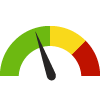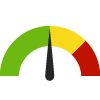Addressing Mental Health and Substance Use Across the Lifespan
- Adverse Childhood Experiences
- Substance Use
- Adolescent Health
- Education
- Housing Overcrowding
- Health and Wellness for Older Adults
Indicator Gauge Icon Legend
Legend Colors
Red is bad, green is good, blue is not statistically different/neutral.
Compared to Distribution
 the value is in the best half of communities.
the value is in the best half of communities.
 the value is in the 2nd worst quarter of communities.
the value is in the 2nd worst quarter of communities.
 the value is in the worst quarter of communities.
the value is in the worst quarter of communities.
Compared to Target
 meets target;
meets target;  does not meet target.
does not meet target.
Compared to a Single Value
 lower than the comparison value;
lower than the comparison value;
 higher than the comparison value;
higher than the comparison value;
 not statistically different from comparison value.
not statistically different from comparison value.
Trend

 non-significant change over time;
non-significant change over time; 
 significant change over time;
significant change over time;  no change over time.
no change over time.
Compared to Prior Value
 higher than the previous measurement period;
higher than the previous measurement period;
 lower than the previous measurement period;
lower than the previous measurement period;
 no statistically different change from previous measurement period.
no statistically different change from previous measurement period.
 Significantly better than the overall value
Significantly better than the overall value
 Significantly worse than the overall value
Significantly worse than the overall value
 Significantly different than the overall value
Significantly different than the overall value
 No significant difference with the overall value
No significant difference with the overall value
 No data on significance available
No data on significance available
Health / Older Adults
People 65+ Living Alone (Count) Census Tract: 06111001201
People 65+ Living Alone (Count) Census Tract: 06111001201

People 65+ Living Alone (Count) Census Tract: 06111001202
People 65+ Living Alone (Count) Census Tract: 06111001202

People 65+ Living Alone (Count) Census Tract: 06111001204
People 65+ Living Alone (Count) Census Tract: 06111001204

People 65+ Living Alone (Count) Census Tract: 06111001302
People 65+ Living Alone (Count) Census Tract: 06111001302

People 65+ Living Alone (Count) Census Tract: 06111001401
People 65+ Living Alone (Count) Census Tract: 06111001401

People 65+ Living Alone (Count) Census Tract: 06111001402
People 65+ Living Alone (Count) Census Tract: 06111001402

People 65+ Living Alone (Count) Census Tract: 06111001506
People 65+ Living Alone (Count) Census Tract: 06111001506

People 65+ Living Alone (Count) Census Tract: 06111001507
People 65+ Living Alone (Count) Census Tract: 06111001507

People 65+ Living Alone (Count) Census Tract: 06111001602
People 65+ Living Alone (Count) Census Tract: 06111001602

People 65+ Living Alone (Count) Census Tract: 06111002000
People 65+ Living Alone (Count) Census Tract: 06111002000

People 65+ Living Alone (Count) Census Tract: 06111002102
People 65+ Living Alone (Count) Census Tract: 06111002102

People 65+ Living Alone (Count) Census Tract: 06111002200
People 65+ Living Alone (Count) Census Tract: 06111002200

People 65+ Living Alone (Count) Census Tract: 06111002400
People 65+ Living Alone (Count) Census Tract: 06111002400

People 65+ Living Alone (Count) Census Tract: 06111002500
People 65+ Living Alone (Count) Census Tract: 06111002500

People 65+ Living Alone (Count) Census Tract: 06111002600
People 65+ Living Alone (Count) Census Tract: 06111002600

People 65+ Living Alone (Count) Census Tract: 06111002700
People 65+ Living Alone (Count) Census Tract: 06111002700

People 65+ Living Alone (Count) Census Tract: 06111002800
People 65+ Living Alone (Count) Census Tract: 06111002800

People 65+ Living Alone (Count) Census Tract: 06111002901
People 65+ Living Alone (Count) Census Tract: 06111002901

People 65+ Living Alone (Count) Census Tract: 06111002905
People 65+ Living Alone (Count) Census Tract: 06111002905

People 65+ Living Alone (Count) Census Tract: 06111003010
People 65+ Living Alone (Count) Census Tract: 06111003010

People 65+ Living Alone (Count) Census Tract: 06111003011
People 65+ Living Alone (Count) Census Tract: 06111003011

People 65+ Living Alone (Count) Census Tract: 06111003013
People 65+ Living Alone (Count) Census Tract: 06111003013

People 65+ Living Alone (Count) Census Tract: 06111003201
People 65+ Living Alone (Count) Census Tract: 06111003201

People 65+ Living Alone (Count) Census Tract: 06111003608
People 65+ Living Alone (Count) Census Tract: 06111003608

People 65+ Living Alone (Count) Census Tract: 06111003700
People 65+ Living Alone (Count) Census Tract: 06111003700

People 65+ Living Alone (Count) Census Tract: 06111003801
People 65+ Living Alone (Count) Census Tract: 06111003801

People 65+ Living Alone (Count) Census Tract: 06111003802
People 65+ Living Alone (Count) Census Tract: 06111003802

People 65+ Living Alone (Count) Census Tract: 06111004000
People 65+ Living Alone (Count) Census Tract: 06111004000

People 65+ Living Alone (Count) Census Tract: 06111004101
People 65+ Living Alone (Count) Census Tract: 06111004101

People 65+ Living Alone (Count) Census Tract: 06111004200
People 65+ Living Alone (Count) Census Tract: 06111004200

People 65+ Living Alone (Count) Census Tract: 06111004304
People 65+ Living Alone (Count) Census Tract: 06111004304

People 65+ Living Alone (Count) Census Tract: 06111004400
People 65+ Living Alone (Count) Census Tract: 06111004400

People 65+ Living Alone (Count) Census Tract: 06111004503
People 65+ Living Alone (Count) Census Tract: 06111004503

People 65+ Living Alone (Count) Census Tract: 06111004504
People 65+ Living Alone (Count) Census Tract: 06111004504

People 65+ Living Alone (Count) Census Tract: 06111004505
People 65+ Living Alone (Count) Census Tract: 06111004505

People 65+ Living Alone (Count) Census Tract: 06111004600
People 65+ Living Alone (Count) Census Tract: 06111004600

People 65+ Living Alone (Count) Census Tract: 06111004704
People 65+ Living Alone (Count) Census Tract: 06111004704

People 65+ Living Alone (Count) Census Tract: 06111004710
People 65+ Living Alone (Count) Census Tract: 06111004710

People 65+ Living Alone (Count) Census Tract: 06111004711
People 65+ Living Alone (Count) Census Tract: 06111004711

People 65+ Living Alone (Count) Census Tract: 06111004715
People 65+ Living Alone (Count) Census Tract: 06111004715

People 65+ Living Alone (Count) Census Tract: 06111004716
People 65+ Living Alone (Count) Census Tract: 06111004716

People 65+ Living Alone (Count) Census Tract: 06111004717
People 65+ Living Alone (Count) Census Tract: 06111004717

People 65+ Living Alone (Count) Census Tract: 06111004901
People 65+ Living Alone (Count) Census Tract: 06111004901

People 65+ Living Alone (Count) Census Tract: 06111004902
People 65+ Living Alone (Count) Census Tract: 06111004902

People 65+ Living Alone (Count) Census Tract: 06111005002
People 65+ Living Alone (Count) Census Tract: 06111005002

People 65+ Living Alone (Count) Census Tract: 06111005004
People 65+ Living Alone (Count) Census Tract: 06111005004

People 65+ Living Alone (Count) Census Tract: 06111005202
People 65+ Living Alone (Count) Census Tract: 06111005202

People 65+ Living Alone (Count) Census Tract: 06111005203
People 65+ Living Alone (Count) Census Tract: 06111005203

People 65+ Living Alone (Count) Census Tract: 06111005204
People 65+ Living Alone (Count) Census Tract: 06111005204

People 65+ Living Alone (Count) Census Tract: 06111005205
People 65+ Living Alone (Count) Census Tract: 06111005205

People 65+ Living Alone (Count) Census Tract: 06111005304
People 65+ Living Alone (Count) Census Tract: 06111005304

People 65+ Living Alone (Count) Census Tract: 06111005305
People 65+ Living Alone (Count) Census Tract: 06111005305

People 65+ Living Alone (Count) Census Tract: 06111005306
People 65+ Living Alone (Count) Census Tract: 06111005306

People 65+ Living Alone (Count) Census Tract: 06111005401
People 65+ Living Alone (Count) Census Tract: 06111005401

People 65+ Living Alone (Count) Census Tract: 06111005403
People 65+ Living Alone (Count) Census Tract: 06111005403

People 65+ Living Alone (Count) Census Tract: 06111005404
People 65+ Living Alone (Count) Census Tract: 06111005404

People 65+ Living Alone (Count) Census Tract: 06111005502
People 65+ Living Alone (Count) Census Tract: 06111005502

People 65+ Living Alone (Count) Census Tract: 06111005503
People 65+ Living Alone (Count) Census Tract: 06111005503

People 65+ Living Alone (Count) Census Tract: 06111005504
People 65+ Living Alone (Count) Census Tract: 06111005504

People 65+ Living Alone (Count) Census Tract: 06111005700
People 65+ Living Alone (Count) Census Tract: 06111005700

People 65+ Living Alone (Count) Census Tract: 06111005801
People 65+ Living Alone (Count) Census Tract: 06111005801

People 65+ Living Alone (Count) Census Tract: 06111005901
People 65+ Living Alone (Count) Census Tract: 06111005901

People 65+ Living Alone (Count) Census Tract: 06111005906
People 65+ Living Alone (Count) Census Tract: 06111005906

People 65+ Living Alone (Count) Census Tract: 06111005907
People 65+ Living Alone (Count) Census Tract: 06111005907

People 65+ Living Alone (Count) Census Tract: 06111005908
People 65+ Living Alone (Count) Census Tract: 06111005908

People 65+ Living Alone (Count) Census Tract: 06111005909
People 65+ Living Alone (Count) Census Tract: 06111005909

People 65+ Living Alone (Count) Census Tract: 06111005910
People 65+ Living Alone (Count) Census Tract: 06111005910

People 65+ Living Alone (Count) Census Tract: 06111005911
People 65+ Living Alone (Count) Census Tract: 06111005911

People 65+ Living Alone (Count) Census Tract: 06111006000
People 65+ Living Alone (Count) Census Tract: 06111006000

People 65+ Living Alone (Count) Census Tract: 06111006200
People 65+ Living Alone (Count) Census Tract: 06111006200

People 65+ Living Alone (Count) Census Tract: 06111006301
People 65+ Living Alone (Count) Census Tract: 06111006301

People 65+ Living Alone (Count) Census Tract: 06111006302
People 65+ Living Alone (Count) Census Tract: 06111006302

People 65+ Living Alone (Count) Census Tract: 06111006400
People 65+ Living Alone (Count) Census Tract: 06111006400

People 65+ Living Alone (Count) Census Tract: 06111006500
People 65+ Living Alone (Count) Census Tract: 06111006500

People 65+ Living Alone (Count) Census Tract: 06111006600
People 65+ Living Alone (Count) Census Tract: 06111006600

People 65+ Living Alone (Count) Census Tract: 06111006700
People 65+ Living Alone (Count) Census Tract: 06111006700

People 65+ Living Alone (Count) Census Tract: 06111006800
People 65+ Living Alone (Count) Census Tract: 06111006800

People 65+ Living Alone (Count) Census Tract: 06111006900
People 65+ Living Alone (Count) Census Tract: 06111006900

People 65+ Living Alone (Count) Census Tract: 06111007000
People 65+ Living Alone (Count) Census Tract: 06111007000

People 65+ Living Alone (Count) Census Tract: 06111007100
People 65+ Living Alone (Count) Census Tract: 06111007100

People 65+ Living Alone (Count) Census Tract: 06111007201
People 65+ Living Alone (Count) Census Tract: 06111007201

People 65+ Living Alone (Count) Census Tract: 06111007202
People 65+ Living Alone (Count) Census Tract: 06111007202

People 65+ Living Alone (Count) Census Tract: 06111007300
People 65+ Living Alone (Count) Census Tract: 06111007300

People 65+ Living Alone (Count) Census Tract: 06111007402
People 65+ Living Alone (Count) Census Tract: 06111007402

People 65+ Living Alone (Count) Census Tract: 06111007403
People 65+ Living Alone (Count) Census Tract: 06111007403

People 65+ Living Alone (Count) Census Tract: 06111007405
People 65+ Living Alone (Count) Census Tract: 06111007405

People 65+ Living Alone (Count) Census Tract: 06111007406
People 65+ Living Alone (Count) Census Tract: 06111007406

People 65+ Living Alone (Count) Census Tract: 06111007505
People 65+ Living Alone (Count) Census Tract: 06111007505

People 65+ Living Alone (Count) Census Tract: 06111007506
People 65+ Living Alone (Count) Census Tract: 06111007506

People 65+ Living Alone (Count) Census Tract: 06111007507
People 65+ Living Alone (Count) Census Tract: 06111007507

People 65+ Living Alone (Count) Census Tract: 06111007508
People 65+ Living Alone (Count) Census Tract: 06111007508

People 65+ Living Alone (Count) Census Tract: 06111007509
People 65+ Living Alone (Count) Census Tract: 06111007509

People 65+ Living Alone (Count) Census Tract: 06111007510
People 65+ Living Alone (Count) Census Tract: 06111007510

People 65+ Living Alone (Count) Census Tract: 06111007511
People 65+ Living Alone (Count) Census Tract: 06111007511

People 65+ Living Alone (Count) Census Tract: 06111007512
People 65+ Living Alone (Count) Census Tract: 06111007512

People 65+ Living Alone (Count) Census Tract: 06111007513
People 65+ Living Alone (Count) Census Tract: 06111007513

People 65+ Living Alone (Count) Census Tract: 06111007607
People 65+ Living Alone (Count) Census Tract: 06111007607

People 65+ Living Alone (Count) Census Tract: 06111007609
People 65+ Living Alone (Count) Census Tract: 06111007609

People 65+ Living Alone (Count) Census Tract: 06111007610
People 65+ Living Alone (Count) Census Tract: 06111007610

People 65+ Living Alone (Count) Census Tract: 06111007611
People 65+ Living Alone (Count) Census Tract: 06111007611

People 65+ Living Alone (Count) Census Tract: 06111007612
People 65+ Living Alone (Count) Census Tract: 06111007612

People 65+ Living Alone (Count) Census Tract: 06111007613
People 65+ Living Alone (Count) Census Tract: 06111007613

People 65+ Living Alone (Count) Census Tract: 06111007614
People 65+ Living Alone (Count) Census Tract: 06111007614

People 65+ Living Alone (Count) Census Tract: 06111007700
People 65+ Living Alone (Count) Census Tract: 06111007700

People 65+ Living Alone (Count) Census Tract: 06111007800
People 65+ Living Alone (Count) Census Tract: 06111007800

People 65+ Living Alone (Count) Census Tract: 06111007901
People 65+ Living Alone (Count) Census Tract: 06111007901

People 65+ Living Alone (Count) Census Tract: 06111007903
People 65+ Living Alone (Count) Census Tract: 06111007903

People 65+ Living Alone (Count) Census Tract: 06111007904
People 65+ Living Alone (Count) Census Tract: 06111007904

People 65+ Living Alone (Count) Census Tract: 06111008001
People 65+ Living Alone (Count) Census Tract: 06111008001

People 65+ Living Alone (Count) Census Tract: 06111008002
People 65+ Living Alone (Count) Census Tract: 06111008002

People 65+ Living Alone (Count) Census Tract: 06111008004
People 65+ Living Alone (Count) Census Tract: 06111008004

People 65+ Living Alone (Count) Census Tract: 06111008005
People 65+ Living Alone (Count) Census Tract: 06111008005

People 65+ Living Alone (Count) Census Tract: 06111008101
People 65+ Living Alone (Count) Census Tract: 06111008101

People 65+ Living Alone (Count) Census Tract: 06111008201
People 65+ Living Alone (Count) Census Tract: 06111008201

People 65+ Living Alone (Count) Census Tract: 06111008202
People 65+ Living Alone (Count) Census Tract: 06111008202

People 65+ Living Alone (Count) Census Tract: 06111008302
People 65+ Living Alone (Count) Census Tract: 06111008302

People 65+ Living Alone (Count) Census Tract: 06111008303
People 65+ Living Alone (Count) Census Tract: 06111008303

People 65+ Living Alone (Count) Census Tract: 06111008304
People 65+ Living Alone (Count) Census Tract: 06111008304

People 65+ Living Alone (Count) Census Tract: 06111008401
People 65+ Living Alone (Count) Census Tract: 06111008401

People 65+ Living Alone (Count) Census Tract: 06111008402
People 65+ Living Alone (Count) Census Tract: 06111008402

People 65+ Living Alone (Count) Census Tract: 06111008700
People 65+ Living Alone (Count) Census Tract: 06111008700

People 65+ Living Alone (Count) Census Tract: 06111008800
People 65+ Living Alone (Count) Census Tract: 06111008800

People 65+ Living Alone (Count) Census Tract: 06111008900
People 65+ Living Alone (Count) Census Tract: 06111008900

People 65+ Living Alone (Count) Census Tract: 06111009100
People 65+ Living Alone (Count) Census Tract: 06111009100

People 65+ Living Below Poverty Level County: Ventura
People 65+ Living Below Poverty Level County: Ventura





People 65+ Living Below Poverty Level Census Place (City): Bell Canyon
People 65+ Living Below Poverty Level Census Place (City): Bell Canyon






People 65+ Living Below Poverty Level Census Place (City): Camarillo
People 65+ Living Below Poverty Level Census Place (City): Camarillo






People 65+ Living Below Poverty Level Census Place (City): Casa Conejo
People 65+ Living Below Poverty Level Census Place (City): Casa Conejo






People 65+ Living Below Poverty Level Census Place (City): Channel Islands Beach
People 65+ Living Below Poverty Level Census Place (City): Channel Islands Beach






People 65+ Living Below Poverty Level Census Place (City): El Rio
People 65+ Living Below Poverty Level Census Place (City): El Rio






People 65+ Living Below Poverty Level Census Place (City): Fillmore
People 65+ Living Below Poverty Level Census Place (City): Fillmore






People 65+ Living Below Poverty Level Census Place (City): Lake Sherwood
People 65+ Living Below Poverty Level Census Place (City): Lake Sherwood






People 65+ Living Below Poverty Level Census Place (City): Meiners Oaks
People 65+ Living Below Poverty Level Census Place (City): Meiners Oaks






People 65+ Living Below Poverty Level Census Place (City): Mira Monte
People 65+ Living Below Poverty Level Census Place (City): Mira Monte






People 65+ Living Below Poverty Level Census Place (City): Moorpark
People 65+ Living Below Poverty Level Census Place (City): Moorpark






People 65+ Living Below Poverty Level Census Place (City): Oak Park
People 65+ Living Below Poverty Level Census Place (City): Oak Park






People 65+ Living Below Poverty Level Census Place (City): Oak View
People 65+ Living Below Poverty Level Census Place (City): Oak View






People 65+ Living Below Poverty Level Census Place (City): Ojai
People 65+ Living Below Poverty Level Census Place (City): Ojai






People 65+ Living Below Poverty Level Census Place (City): Oxnard
People 65+ Living Below Poverty Level Census Place (City): Oxnard






People 65+ Living Below Poverty Level Census Place (City): Piru
People 65+ Living Below Poverty Level Census Place (City): Piru






People 65+ Living Below Poverty Level Census Place (City): Port Hueneme
People 65+ Living Below Poverty Level Census Place (City): Port Hueneme






People 65+ Living Below Poverty Level Census Place (City): San Buenaventura (Ventura)
People 65+ Living Below Poverty Level Census Place (City): San Buenaventura (Ventura)






People 65+ Living Below Poverty Level Census Place (City): Santa Paula
People 65+ Living Below Poverty Level Census Place (City): Santa Paula






People 65+ Living Below Poverty Level Census Place (City): Santa Rosa Valley
People 65+ Living Below Poverty Level Census Place (City): Santa Rosa Valley






People 65+ Living Below Poverty Level Census Place (City): Santa Susana
People 65+ Living Below Poverty Level Census Place (City): Santa Susana






People 65+ Living Below Poverty Level Census Place (City): Saticoy
People 65+ Living Below Poverty Level Census Place (City): Saticoy






People 65+ Living Below Poverty Level Census Place (City): Simi Valley
People 65+ Living Below Poverty Level Census Place (City): Simi Valley






People 65+ Living Below Poverty Level Census Place (City): Thousand Oaks
People 65+ Living Below Poverty Level Census Place (City): Thousand Oaks






People 65+ Living Below Poverty Level Zip Code: 91320
People 65+ Living Below Poverty Level Zip Code: 91320




People 65+ Living Below Poverty Level Zip Code: 91360
People 65+ Living Below Poverty Level Zip Code: 91360





